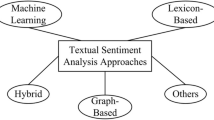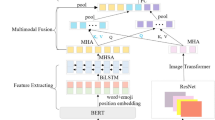Abstract
Recent years have witnessed a rapid spread of multi-modality microblogs like Twitter and Sina Weibo composed of image, text and emoticon. Visual sentiment prediction of such microblog based social media has recently attracted ever-increasing research focus with broad application prospect. In this paper, we give a systematic review of the recent advances and cutting-edge techniques for visual sentiment analysis. To this end, in this paper we review the most recent works in this topic, in which detailed comparison as well as experimental evaluation are given over the cutting-edge methods. We further reveal and discuss the future trends and potential directions for visual sentiment prediction.
Similar content being viewed by others
Explore related subjects
Discover the latest articles and news from researchers in related subjects, suggested using machine learning.References
Picard R W. Affective Computing. MIT Technical Report. 1995
Pang B, Lee L, Vaithyanathan S. Thumbs up?: sentiment classification using machine learning techniques. In: Proceedings of the ACL- 02 Conference on Empirical Methods in Natural Language Processing. 2002, 79–86
Wilson T, Wiebe J, Hwa R. Just how mad are you? Finding strong and weak opinion clauses. In: Proceedings of National Conference on Artificial Intelligence. 2004, 761–767
Zhou L, Li B, Gao W, Wei Z, Wong K F. Unsupervised discovery of discourse relations for eliminating intra-sentence polarity ambiguities. In: Proceedings of the Conference on Empirical Methods in Natural Language Processing. 2011, 162–171
Hu M Q, Liu B. Mining and summarizing customer reviews. In: Proceedings of ACM SIGKDD International Conference on Knowledge Discovery and Data Mining. 2004, 168–177
Wilson T, Wiebe J, Hoffmann P. Recognizing contextual polarity in phrase-level sentiment analysis. In: Proceedings of the Conference on Human Language Technology and Empirical Methods in Natural Language Processing. 2005, 347–354
Liu JJ, Cao Y B, Lin C Y, Huang Y L, Zhou M. Low-quality product review detection in sentiment summarization. In: Proceedings of the Joint Conference on Empirical Methods in Natural Language Processing and Computational Natural Language Learning. 2007
McGlohon M, Glance N S, Reiter Z. Star quality: aggregating reviews to rank products and merchants. In: Proceedings of the International Conference on Weblogs and Social Media. 2010
Joshi M, Das D, Gimpel K, Smith N A. Movie reviews and revenues: an experiment in text regression. In: Proceedings of the 2010 Annual Conference of the North American Chapter of the Association for Computational Linguistics. 2010, 293–296
Feldman R, Rosenfeld B, Bar-Haim R, Fresko M. The stock sonar_ sentiment analysis of stocks based on a hybrid approach. In: Proceedings of the 23rd IAAI Conference on Artificial Intelligence. 2011
Zhang W B, Skiena S. Trading strategies to exploit blog and news sentiment. In: Proceedings of the International Conference on Weblogs and Social Media. 2010
Tumasjan A, Sprenger T O, Sandner P G, Welpe I M. Predicting elections with twitter: what 140 characters reveal about political sentiment. In: Proceedings of the International Conference onWeblogs and Social Media. 2010, 178–185
Chen B, Leilei Z, Daniel K, Dongwon L. What is an sentiment about? exploring political standpoints using sentiment scoring model. In: Proceeedings of AAAI Conference on Artificial Intelligence. 2010
Yano T, Smith N A. What’s worthy of comment? content and comment volume in political blogs. In: Proceedings of the International AAAI Conference on Weblogs and Social Media. 2010
Groh G, Hauffa J. Characterizing social relations via NLP-based sentiment analysis. In: Proceedings of the 5th International AAAI Conference on Weblogs and Social Media. 2011
Li B, Feng S, Xiong W, Hu W. Scaring or pleasing: exploit emotional impact of an image. In: Proceedings of the 20th ACM International Conference on Multimedia. 2012, 1365–1366
Jia J, Wu S, Wang X H, Hu P Y, Cai L H, Tang J. Can we understand van Gogh’s mood?: learning to infer affects from images in social networks. In: Proceedings of the 20th ACM International Conference on Multimedia. 2012, 857–860
Vonikakis V, Winkler S. Emotion-based sequence of family photos. In: Proceedings of the 20th ACM International Conference onMultimedia. 2012, 1371–1372
Siersdorfer S, Minack E, Deng F, Hare J. Analyzing and predicting sentiment of images on the social Web. In: Proceedings of the 18th ACM International Conference on Multimedia. 2010, 715–718
Borth D, Ji R, Chen T, Breuel T, Chang S F. Large-scale visual sentiment ontology and detectors using adjective noun pairs. In: Proceedings of the 21st ACM International Conference on Multimedia. 2013, 223–232
Yuan J, Mcdonough S, You Q, Luo J. Sentribute: image sentiment analysis from a mid-level perspective. In Proceedings of the 2nd International Workshop on Issues of Sentiment Discovery and Opinion Mining. 2013
Cao D L, Ji R R, Lin A Z, Li S Z. Visual sentiment topic model based microblog image sentiment analysis. Multimedia Tools and Applications, 2014: 1–14
Ji R R, Yao H X, Liu W, Sun X S, Tian Q. Task dependent visual codebook compression, IEEE Transactions on Image Processing, 2012, 21(4): 2282–2293
Ji R R, Duan L Y, Yao H X, Xie L X, Rui Y, Gao W. Learning to distribute vocabulary indexing for scalable visual search. IEEE Transactions on Multimedia, 2013, 15(1): 153–166
Ji R R, Gao Y, Liu W, Xie X, Qi Tian, Li X L. When location meets social multimedia: a comprehensive survey on location-aware social multimedia. ACM Transactions on Intelligent System and Technology, 2015, 6(1): 1–18
Ji R R, Yao H X, Tian Q, Xu P F, Sun X S, Liu X M, Context-aware semi-local feature detector. ACM Transactions on Intelligent System and Technology, 2012, 3(3): 44–71
Ji R R, Yu F X, Chang S F. Active query sensing for mobile location search. ACM Transactions on Multimedia Computing, Communications and Applications, 2012, 3S(8): 40–61
Ji R R, Gao Y, Zhong B N, Yao H X, Tian Q. Mining flickr landmarks bymodeling reconstruction sparsity. ACM Transactions onMultimedia Computing, Communications and Applications, 2011, 7S(1)
Ji R R, Duan L Y, Chen J, Huang T J, Gao W. Mining compact 3D patterns for low bit rate mobile visual search. IEEE Transactions on Image Processing, 2014, 23(7): 3099–3113
You Q Z, Luo J B, JinH L, Yang J C. Robust image sentiment analysis using progressively trained and domain transferred deep networks. 2015, arXiv:1509.06041
Chen T, Yu F X, Chen J, CuiY, Chen Y Y, Chang S F. Object-based visual sentiment concept analysis and application. In: Proceedings of the ACM International Conference on Multimedia. 2014, 367–376.
Li L X, Cao D L, Li S Z, Ji R R. Sentiment analysis of Chinese micro-blog based on multi-modal correlation model. In: Proceedings of the 2015 IEEE International Conference on Image Processing. 2015, 4798–4802
Chen F H, Gao Y, CAO D L. Multimodal hypergraph learning for microblog sentiment prediction. In: Proceedings of the 2015 IEEE International Conference on Multimedia and Expo. 2015, 1–6
Wang M, Cao D L, Li L X, Li S Z, Ji R R. Microblog sentiment analysis based on cross-media bag-of-words model. In: Proceedings of International Conference on Internet Multimedia Computing and Service. 2014
You Q Z, Luo J B, Jin H L, Yang J C. Cross-modality consistent regression for joint visual-textual sentiment analysis. In: Proceedings of the 9th ACM International Conference on Web Search and Data Mining. 2016, 13–22
Zhong B N, Yao H X, Chen S, Ji R R, Chin T J, Wang H Z. Visual tracking via weakly supervised learning from multiple imperfect oracles. Pattern Recognition, 2014, 47(3): 1395–1410
Gao Y, Wang F L, Luan H B, Chua T S. Brand data gathering from live social media streams. In: Proceedings of ACM International Conference on Multimedia Retrieval. 2014
Gao Y, Wang M, Zha Z J, Shen J L, Li X L, Wu X D. Visual-textual joint relevance learning for tag-based social image search. IEEE Transactions on Image Processing, 2013, 22(1): 363–376
Gao Y, Wang M, Zha Z J, Tian Q, Dai Q H, Zhang N Y. Less is more: efficient 3-D object retrieval with query view selection. IEEE Transactions on Multimedia, 2011, 13(5): 1007–1018
Gao Y, Tang J H, Hong R C, Yan S C, Dai Q H, Zhang N Y, Chua T S. Camera constraint-free view-based 3-D object retrieval. IEEE Transactions on Image Processing, 2012, 21(4): 2269–2281
Huang Y C, Liu Q S, Zhang S T, Metaxas D N. Image retrieval via probabilistic hypergraph ranking. In: Proceedings of the 2010 IEEE Conference on Computer Vision and Pattern Recognition. 2010, 3376–3383
Gao Y, Wang M, Zha Z J, Shen J L, Li X L, Wu X D. Visual-textual joint relevance learning for tag-based social image search. IEEE Transactions on Image Processing, 2013, 22(1): 363–376
Cai Z, Cao D L, Ji R R. Video (GIF) sentiment analysis using largescale mid-level ontology. 2015, arXiv:1506.00765
Wang Y L, Wang S H, Tang J L, Huan Liu H, Li B X. Unsupervised sentiment analysis for social media images. In: Proceedings of the 24th International Conference on Artificial Intelligence. 2015, 2378–2379
Narihira T, Borth D, Yu S X, Ni K, Darrell T. Mapping images to sentiment adjective noun pairs with factorized neural nets. 2015, arXiv preprint arXiv:1511.06838
Author information
Authors and Affiliations
Corresponding author
Additional information
Rongrong Ji received his PhD degree in computer science from Harbin Institute of Technology, China. He was a Postdoc research fellow in Columbia University, USA from 2010 to 2013. He is the author of over 50 tier-1 journals and conferences in IJCV, TIP, ICCV, CVPR, ACM Multimedia, IJCAI, AAAI, etc. Dr. Ji is the recipient of the Best Paper Award at ACM Multimedia 2011 and Microsoft Fellowship 2007. Besides, he is the awardee of the NSFC Excellent Young Scholars Program in 2014. He is currently a professor at the Department of Cognitive Science, School of Information Science and Engineering, Xiamen University, China. His research interests include image and video search, content understanding, mobile visual search and recognition, as well as interactive human-computer interface.
Donglin Cao is currently an assistant professor at the Department of Cognitive Science, School of Information Science and Engineering, Xiamen University, China. His research interest is cross-media information retrieval.
Yiyi Zhou is currently pursuing his PhD in computer science at Xiamen University, China. He received his MS degree from Durham University, UK and BE degree from Dalian Jiaotong University, China. His research interests include social media, multimedia analysis and machine learning.
Fuhai Chen received the BS degree in information and computing science from Xiamen University (XMU), China in 2014. He is currently working towards his master degree at XMU. His research interests include machine learning and computer scene understanding.
Electronic supplementary material
Rights and permissions
About this article
Cite this article
Ji, R., Cao, D., Zhou, Y. et al. Survey of visual sentiment prediction for social media analysis. Front. Comput. Sci. 10, 602–611 (2016). https://doi.org/10.1007/s11704-016-5453-2
Received:
Accepted:
Published:
Issue Date:
DOI: https://doi.org/10.1007/s11704-016-5453-2




